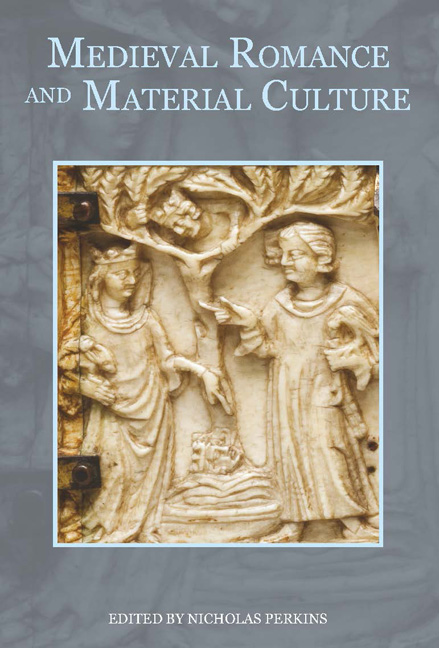Book contents
- Frontmatter
- Contents
- List of Illustrations
- List of Contributors
- Acknowledgements
- Abbreviations
- 1 Introduction: The Materiality of Medieval Romance and The Erle of Tolous
- 2 Courtly Culture and Emotional Intelligence in the Romance of Horn
- 3 Emplaced Reading, or Towards a Spatial Hermeneutic for Medieval Romance
- 4 Devotional Objects, Saracen Spaces and Miracles in Two Matter of France Romances
- 5 The Werewolf of Wicklow: Shapeshifting and Colonial Identity in the Lai de Melion
- 6 ‘Ladyes war at thare avowing’: The Female Gaze in Late-Medieval Scottish Romance
- 7 The Evolution of Cooperation in The Avowyng of Arthur
- 8 Ritual, Revenge and the Politics of Chess in Medieval Romance
- 9 Adventures in the Bob-and-Wheel Tradition: Narratives and Manuscripts
- 10 Reading King Robert of Sicily's Text(s) and Manuscript Context(s)
- 11 The Circulation of Romances from England in Late-Medieval Ireland
- 12 The Image of the Knightly Harper: Symbolism and Resonance
- 13 Carving the Folie Tristan: Ivory Caskets as Material Evidence of Textual History
- 14 Romancing the Orient: The Roman d'Alexandre and Marco Polo's Livre du grand Khan in Oxford, Bodleian Library MS Bodl. 264
- 15 The Victorian Afterlife of The Thornton Romances
- Index
12 - The Image of the Knightly Harper: Symbolism and Resonance
Published online by Cambridge University Press: 05 May 2015
- Frontmatter
- Contents
- List of Illustrations
- List of Contributors
- Acknowledgements
- Abbreviations
- 1 Introduction: The Materiality of Medieval Romance and The Erle of Tolous
- 2 Courtly Culture and Emotional Intelligence in the Romance of Horn
- 3 Emplaced Reading, or Towards a Spatial Hermeneutic for Medieval Romance
- 4 Devotional Objects, Saracen Spaces and Miracles in Two Matter of France Romances
- 5 The Werewolf of Wicklow: Shapeshifting and Colonial Identity in the Lai de Melion
- 6 ‘Ladyes war at thare avowing’: The Female Gaze in Late-Medieval Scottish Romance
- 7 The Evolution of Cooperation in The Avowyng of Arthur
- 8 Ritual, Revenge and the Politics of Chess in Medieval Romance
- 9 Adventures in the Bob-and-Wheel Tradition: Narratives and Manuscripts
- 10 Reading King Robert of Sicily's Text(s) and Manuscript Context(s)
- 11 The Circulation of Romances from England in Late-Medieval Ireland
- 12 The Image of the Knightly Harper: Symbolism and Resonance
- 13 Carving the Folie Tristan: Ivory Caskets as Material Evidence of Textual History
- 14 Romancing the Orient: The Roman d'Alexandre and Marco Polo's Livre du grand Khan in Oxford, Bodleian Library MS Bodl. 264
- 15 The Victorian Afterlife of The Thornton Romances
- Index
Summary
This essay explores the symbolism and material contexts of a number of knightly figures who play the harp in twelfth-century Insular texts. Tristan is perhaps the best known of the harpers, and Horn is close at his heels, followed by the more problematic Hereward. The texts in which these figures appear differ significantly in form, and they find striking parallels in other twelfth-century works, including chronicles and saints’ lives. Both Horn and Tristan either harp or refer to their harping in the course of their narratives and this particular attribute of the hero, reinforced by the stories of historic harpers who appear in other contemporary texts, emphasizes an aspect of the characters’ heroism that somehow sets them apart and becomes integral to their identities; in the case of Tristan, the iconography of the hero harping serves to identify him outside his literary context, as would a saint's emblem. The hero is presented with a material attribute that goes beyond those of his contemporaries and that both elevates and enhances him. The symbolism and significance of harping define certain aspects of this nexus of characters whose identities are bound to one another through the instrument they play and with which one of them is portrayed in visual art. These images evoke diverse literary and material contexts and reflect the varied nature of the Insular sources on which Anglo-Norman authors drew: the stories examined here look both to Anglo-Saxon and Celtic traditions, as well as to Biblical imagery.
Tristan harps in several different contexts in the early texts in which he appears. Three of these contexts were emblematic enough to have been preserved in a series of thirteenth-century floor tiles discovered at Chertsey Abbey in the nineteenth century. As Melissa Furrow has recently argued, the tiles would not serve to tell the story of Tristan, but rather to remind viewers of what they knew already.
- Type
- Chapter
- Information
- Medieval Romance and Material Culture , pp. 199 - 214Publisher: Boydell & BrewerPrint publication year: 2015



